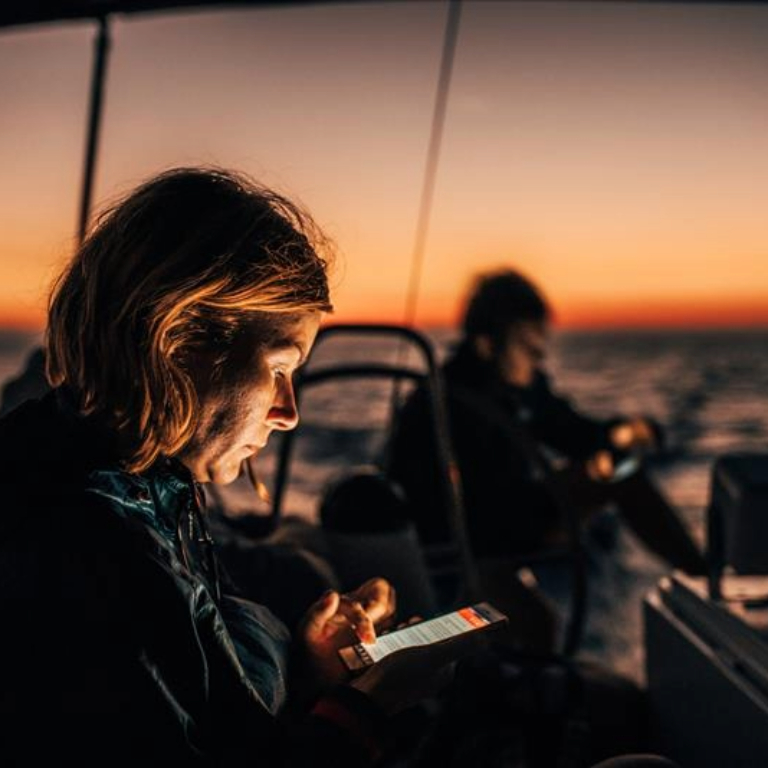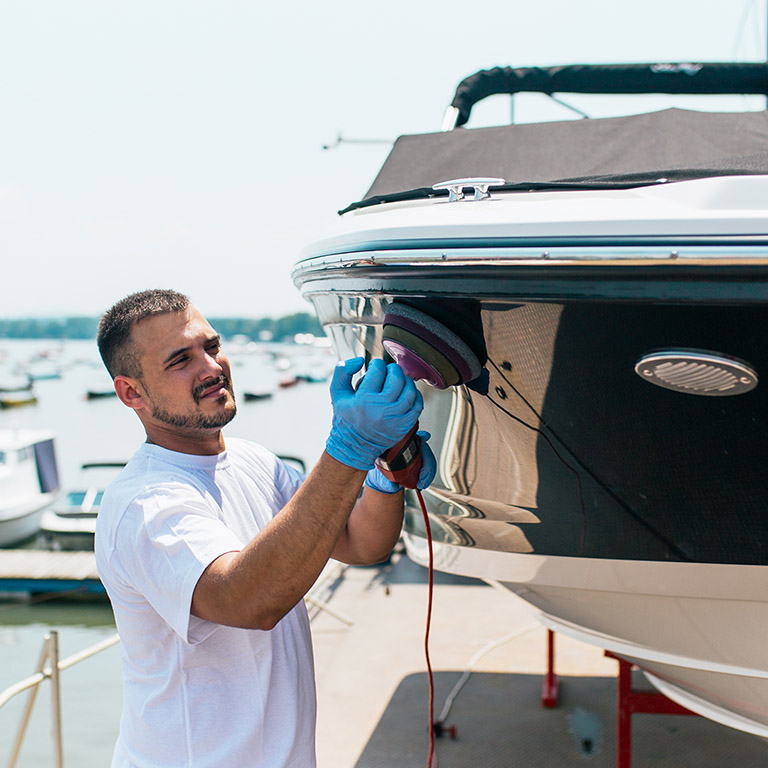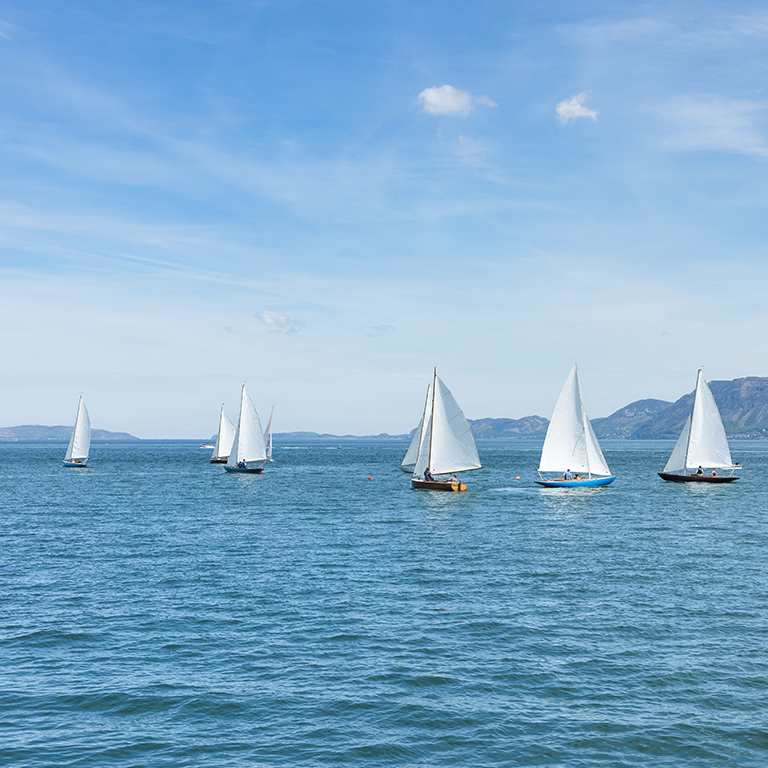If you're new to sailing it can be overwhelming to get to grips with the rules, techniques and equipment – especially when some of the terminology used is unfamiliar.
To help navigate some of the common phrases, we've rounded up a few key terms that will come in handy whether you're the captain of a dinghy or a luxury yacht.
The main sailing terms you need to know:
- Boat positions
- Boat equipment
- Sailing positions and movements
- Lesser-known sailing terms
- Geographic positioning terms
- Weather
- Essential knots
The main boating rules in the UK:
The main sailing terms you need to know
Boat positions
- Bow – front of the boat
- Stern – back of the boat
- Port – left side of the boat when facing the bow
- Starboard - right side of the boat when facing the bow
- Aft - toward the back of the boat
- Forward - toward the front of the boat
- Amidships - in the middle of the boat
- Centerline - an imaginary line running down the center of the boat from bow to stern
- Transom - flat surface at the stern of the boat where the outboard motor is attached
- Beam - width of the boat at its widest point, usually measured at amidships
- Helm – controls the boat's direction, and could be a wheel or a tiller
Boat equipment
- Keel – a blade or fin attached to the bottom of sailboats to provide stability
- Lines – nautical term used instead of ropes
- Mainsail – a boat's largest and most important sail
- Boom – the thick, horizontal pole which extends from the bottom of the mast
- Jib - the smaller sail at the front of the boat, without a boom
- Rudder – located beneath the boat, a flat structure attached to help steer the boat
- Halyard – the rope used to hoist and lower sails
- Anchor - A heavy object that is dropped to the bottom of the water to keep the boat in place
- Bilge pump - A pump used to remove water from the bottom of the boat
- Life jacket - a personal flotation device worn by a person to help them float in the water
- Fenders - cushions placed on the side of the boat to protect it from damage when moored
- GPS - global positioning system, a device used to determine the boat's location and navigate
- VHF radio - a type of radio used for communication between boats and with shore stations
- Flares - emergency signalling devices used to attract attention
- Navigation lights - lights used to indicate the boat's position and direction of travel at night
- Depth sounder - a device used to measure the depth of water beneath the boat
- Horn - a sound-making device used to signal other boats or to indicate danger
Sailing positions and movements
- Point of sail - the boat's direction relative to the wind
- Heeling - the term for when a sailboat leans over in the water as it sails
- Tacking – changing the direction of the boat by turning the bow through the wind
- Gybing – opposite to tacking, changing direction by turning the stern of the boat through the wind
- Windward - the side of the boat closest to the wind
- Leeward - the side of the boat furthest from the wind
- Jibing - Turning the boat away from the wind so that the sails change from one side to the other
- Point of sail - The angle between the direction of the wind and the direction the boat is travelling
- Close-hauled - Sailing as close to the wind as possible
- Beam reach - Sailing perpendicular to the wind
- Broad reach - Sailing with the wind coming from behind the boat
- Running - Sailing with the wind coming directly from behind the boat
- Luffing - When the sail flutters because it is not filled with wind
Lesser-known sailing terms
- Draft - the distance between the waterline and the lowest point of the keel (i.e. minimum water depth needed to float)
- Apeak - when a sailboat is stopped or at anchor with the bow pointed directly into the wind
- Bight - a loop or bend in a rope, line, or chain
- Chafe - damage or wear on a line caused by friction or rubbing against a surface
- Doghouse - a raised structure on a boat that provides standing headroom in the cabin area
- Fairlead - a fitting used to guide a line in the desired direction
- Hank - a clip or hook that attaches the sail to the stay or the mast
- Mizzen - the aft sail on a ketch or yawl rigged sailboat
- Sheave - a pulley-like device used for hoisting or lowering a sail or line
- Tiller – a lever used to steer the boat by moving the rudder
Geographic positioning terms
- Latitude - a geographic coordinate, expressed in degrees, that measures the distance of a location north or south of the equator
- Longitude - much like latitude, but measures the distance of a location east or west of the prime meridian running through Greenwich
- International date line - meridian line which is 180 degrees (i.e. opposite) from the prime longitude line in Greenwich
- Nautical mile - a unit of measurement used in navigation and is defined as the distance equivalent to one minute of latitude
Weather
- Atmosphere - layers of gases that surround the Earth and influence the weather patterns and conditions that we experience
- Pressure - the force exerted by the weight with in area of the Earth's atmosphere, often referred to as 'high pressure' or 'low pressure'
- Barometer - used to measure atmospheric pressure
- Forecast - estimates of future weather conditions in a given area based on current changes within the atmosphere
- High pressure system - weather characterized by sinking air that results in clear skies, dry conditions, and generally fair weather
- Low pressure system - weather that is typically characterized by rising air that results in cloudy, stormy, or rainy conditions, and more unstable weather
- Wind - the natural movement of air in the Earth's atmosphere, usually caused by differences in temperature and pressure, and described by its origin i.e. where the wind is coming from (e.g. south westerly, northern, etc.)
- Trade winds - steady, reliable winds that blow towards the equator from the northeast in the Northern Hemisphere and from the southeast in the Southern Hemisphere, typically between 5 and 30 degrees latitude
- Apparent wind - is the speed and direction and wind indicated by a wind instrument on a moving craft in undisturbed air. It is composed of the combined speeds and directions of the craft and wind observed by a stationary wind instrument - the true wind
- Starboard tack - when the wind is coming from the starboard side of the boat
- Port tack - when the wind is coming from the port side of the boat
Essential knots
- Half-hitch – is also known as an overhand knot. This type of knot is used to secure a line or rope to a fixed object, like a tree. The first part of the knot is a round turn, which controls the load and provides friction against the support
- Figure eight - used to secure a rope that is already passed around a post or through a ring. It is quick and easy to tie and untie
- Bowline - a strong and secure knot used to form a fixed loop at the end of a rope that will not slip or come undone under load, and it is widely used in sailing, rescue operations, and other outdoor activities
- Clove hitch - used to secure a rope to a post or pole, consisting of two loops around the object and a crossing turn on the inside of the loop
- Cleat hitch - used to secure a rope to a cleat, which is a device with two horns or arms that is often used to tie off a boat or ship to a dock or pier, or to secure other objects on board
What are the main boating rules in the UK?
General boating regulations
- All boats must display navigation lights after sunset and before sunrise or in restricted visibility conditions, to ensure that other boats can see them and avoid collisions
- Speed limits apply in certain areas, such as near marinas, harbours, or built-up areas, and must be obeyed to avoid accidents and disturbance to other boaters and water users
- Boats must give way to other vessels in certain situations, such as when crossing or overtaking, and should use sound signals and visual signals, such as flags or hand gestures, to communicate with other boats when necessary
- The skipper of a boat is responsible for the safety of the vessel and its crew, and should ensure that all necessary safety equipment, such as first aid kit, fire extinguisher, and distress signals, are on board and in good working order.
- Boaters should be aware of the local weather and tides, and plan their journeys accordingly, taking into account factors such as wind, waves, currents, and potential hazards.
- Boaters should also be considerate of the environment and wildlife, and avoid disturbing or damaging sensitive areas, such as nesting sites, marine reserves, or areas with high biodiversity.
- The use of alcohol and drugs is strictly prohibited when operating a boat, as they can impair judgment, reflexes, and coordination, and increase the risk of accidents and injuries.
- Using inland waterways in the UK typically requires third party boat insurance for at least £1 million, especially if you have a powered boat or a houseboat.
Marine conduct for collision avoidance
- Always keep a lookout visually and audibly to avoid collisions with other boats
- Maintain control of your boat at all times including safe speeds
- When two sailboats approach each other with the wind on different sides, the sailing vessel with wind on the port side gives way
- The boat to leeward has right of way when two sailboats are approaching each other with the wind on the same side
- A boat on the starboard side should be given the right of way (if collision course present)
- Always give plenty of room whilst overtaking another vessel
- Sailboats should yield to vessels that are restricted in their ability to manoeuvre, or engaged in fishing (i.e. not under command)
- Stay close to the outer edge when passing through a narrow channel
- Powerboats typically give way to sailboats, except for much larger vessels (e.g. cruise liner) which have difficulty changing course or speed, especially in narrow channels
Key takeaway
There's a lot to take in when starting out, and even when you've mastered these key sailing terms, you'll find there are many more.
But, don't worry. The more time you spend on the water, with friends and other sailing enthusiasts, the more terms and phrases you'll discover, and the jargon which once seemed alien will become second nature.


